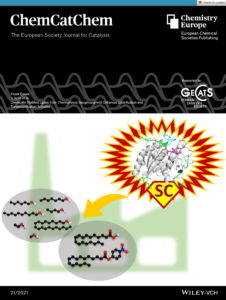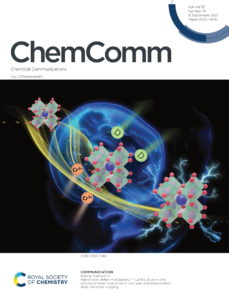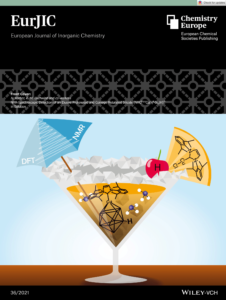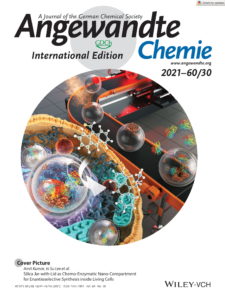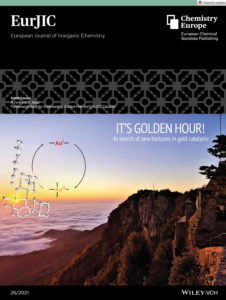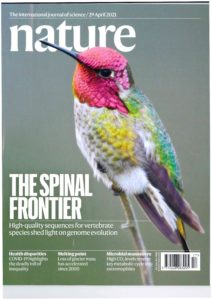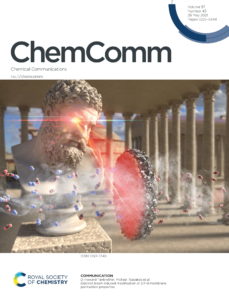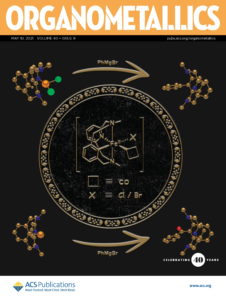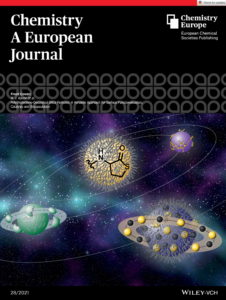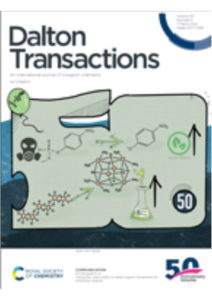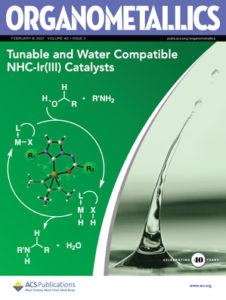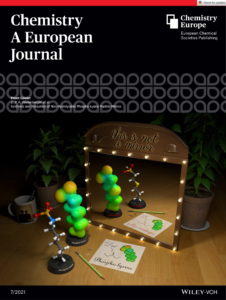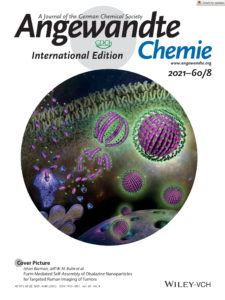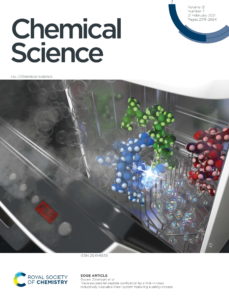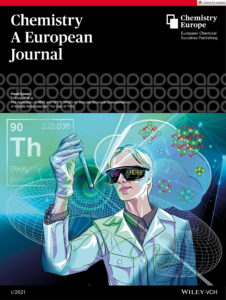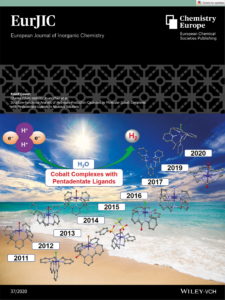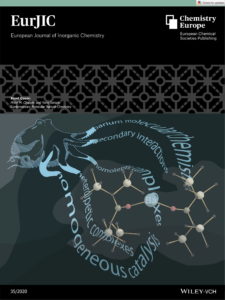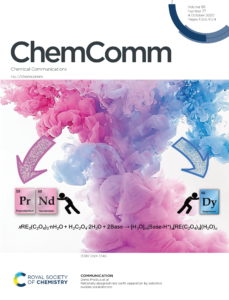Publications
latest publications:
by: Wiesinger, Michael; Knüpfer, Christian; Holger, Elsen; Mai, Jonathan; Langer, Jens; Harder, Sjoerd; ChemCatChem (2021), 13(21), 4567-4577; Language: English, Database: CAplus Reaction of a MgN“2/BaN”2 mixture (N“=N(SiMe3)2) with PhSiH3 gave three unique heterometallic Mg/Ba hydride clusters: Mg5Ba4H11N”7 ⋅ (benzene)2 (1), Mg4Ba7H13N“9 ⋅ (toluene)2 (2) and Mg7Ba12H26N”12 (3). Product formation is controlled by the Mg/Ba ratio and temperature. Crystal structures are described. While 3 is fully insoluble, clusters 1 and 2 retain their structures in aromatic solvents. DFT calculations and AIM analyses indicate highly ionic bonding with Mg−H and Ba−H bond paths. Also unusual H−⋅⋅⋅H− bond paths are observed. Catalytic hydrogenation with MgN“2, BaN”2 and the mixture...Heterometallic Mg-Ba Hydride Cluster in Hydrogenation Catalysis Publikation 203 als PDF laden (4.701 KB)
By: Roesch, Bastian; Harder, Sjoerd Chemical Communications (Camebridge, United Kingdom) (2021), 57(74), 9354-9365 Language: English, Database: CAplus and MEDLINE A review. Since the seminal report on Mg in the +1 oxidation state in 2007, low-valent complexes featuring a MgI-MgI bond developed from trophy mols. to state-of-the-art reducing agents. Despite increasing interest in low-valency of the other group 2 metals...New horizons in low oxidation state group 2 metal chemistry Publikation 202 als PDF laden (5.722 KB)
By: Wiesinger, Michael; Rosch, Bastian; Knuepfer, Christian; Mai, Jonathan; Langer, Jens; Harder, Sjoerd European Journal of Inorganic Chemistry (2021), 2021(36), 3731-3741 | Language: English, Database: CAplus Reaction of [(DipePBDI)SrH]2 with C6H5X (X = Cl, Br, I) led to hydride-halogenide exchange (DipePBDI = HC[(Me)CN-2,6-(3-pentyl)phenyl]2). Conversion rates increase with increasing halogen size (F < Cl < Br < I). Reaction of [(DipePBDI)SrH]2 with C6H5F was slow and ill-defined but addition of C6H4F2 gave smooth hydride-fluoride exchange. After addition of THF the full range of Sr halogenides was structurally characterized: [(DipePBDI)SrX·THF]2 (X = F, Cl, Br, I)...Carbon-Halogen Bond Activation with Powerful Heavy Alkaline Earth Metal Hydrides Publikation 201 als PDF laden (2.598 KB)
By: Friedrich, Alexander; Eyselein, Jonathan; Langer, Jens; Farber, Christian; Harder, Sjoerd Angewandte Chemie, International Edition (2021), 60(30), 16492-16499 | Language: English, Database: CAplus and MEDLINE Low-valent (Me-BDI)Al and (Me-BDI)Ga and highly Lewis acidic cations in [(tBu-BDI)M+·C6H6][B(C6F5)4-] (M = Mg or Zn, Me-BDI = HC[CMe:NDipp]2, tBu-BDI = HC[C(tBu):NDipp]2, Dipp = 2,6-iPr2C6H3) react to heterobimetallic cations [(tBu-BDI)Mg-Al(Me-BDI)+], [(tBu-BDI)Mg-Ga(Me-BDI)+] and [(tBu-BDI)Zn-Ga(Me-BDI)+]. These cations feature long Mg-Al (or Ga) bonds while the Zn-Ga bond is short. The [(tBu-BDI)Zn-Al(Me-BDI)+] cation was not formed. Combined AIM and charge calculations suggest that...Cationic Heterobimetallic Mg(Zn)/Al(Ga) Combinations for Cooperative C–F Bond Cleavage Publikation 200 als PDF laden (1.953 KB)
By: Thum, Katharina; Martin, Johannes; Elsen, Holger; Eyselein, Jonathan; Stiegler, Lena; Langer, Jens; Harder, Sjoerd European Journal of Inorganic Chemistry (2021), 2021(26), 2643-2653 | Language: English, Database: CAplus Lewis acidic (BDI)Ae+ cations of the heavier metals Sr and Ba, which are not stabilized by polar solvents, have been obtained by double deprotonation of (BDI)H2+ with either SrN''2 or BaN''2; BDI = HC[C(Me)N(DIPP)]2, DIPP = 2,6-diisopropylphenyl, Ae = alk. earth, N'' = N(SiMe3)2. Due to...Lewis Acidic Cationic Strontium and Barium Complexes Publikation 199 als PDF laden (4.851 KB)
By: Roesch, B.; Gentner, T. X.; Eyselein, J.; Langer, J.; Elsen, H.; Harder, S. Nature (London, United Kingdom) (2021), 592(7856), 717-721 | Language: English, Database: CAplus and MEDLINE A complex of a metal in its zero oxidation state can be considered a stabilized, but highly reactive, form of a single metal atom. Such complexes are common for the more noble transition metals. Although rare examples are known for electroneg. late-main-group p-block metals or semimetals1-6, it is a challenge to isolate early-main-group s-block metals in their zero oxidation state7-11. This is directly related to their very low electronegativity and strong tendency to oxidize. Here the authors present examples of zero-oxidation-state magnesium (i.e., magnesium(0)) complexes that are stabilized by superbulky, monoanionic, β-diketiminate ligands. Whereas the reactivity of an organomagnesium compound is typically defined by the nucleophilicity of its organic groups...Strongly reducing magnesium(0) complexes Publikation als PDF laden (2.538 KB)
By: Thum, Katharina; Pahl, Juergen; Eyselein, Jonathan; Elsen, Holger; Langer, Jens; Harder, Sjoerd Chemical Communications (Cambridge, United Kingdom) (2021), 57(43), 5278-5281 | Language: English, Database: CAplus and MEDLINE First evidence for the coordination of norbornadiene (nbd) and dicyclopentadiene (dcpd) with the main group metal Mg is provided by the crystal structures of adducts with cationic β-diketiminate (BDI) Mg complexes. While the dcpd complex is thermally stable, [(BDI)Mg+·nbd][B(C6F5)4-] shows slow room temperature retro-Diels-Alder decomposition to give a complex with the cation (BDI)Mg(C5H5)Mg(BDI)+...Retro-Diels–Alder decomposition of norbornadiene mediated by a cationic magnesium complex Publikation 198 als PDF laden (2.501 KB)
By: Roesch, Bastian; Martin, Johannes; Eyselein, Jonathan; Langer, Jens; Wiesinger, Michael; Harder, Sjoerd Organometallics (2021), 40(9), 1395-1401 | Language: English, Database: CAplus A graphical abstract related to Application of a Stable and Soluble Dibenzylbarium Reagent in the Synthesis of a Barium Imido Cluster (DMAT)2Ba·(THF)2 (DMAT = 2-dimethylamino-α-trimethylsilylbenzyl) was prepared by a salt metathesis reaction between (DMAT)K and BaI2 in THF, and crystals were isolated in 83% yield. This monomeric complex dissolves well in aromatic or ethereal solvents and is also stable at higher temperatures in solution Structural details and NMR parameters reveal a high degree of charge delocalization in the DMAT aryl ring...Application of a Stable and Soluble Dibenzylbarium Reagent in the Synthesis of a Barium Imido Cluster Publikation 197 online lesen
By: Friedrich, Alexander; Eyselein, Jonathan; Elsen, Holger; Langer, Jens; Pahl, Juergen; Wiesinger, Michael; Harder, Sjoerd Chemistry - A European Journal (2021), 27(28), 7756-7763 | Language: English, Database: CAplus and MEDLINE Strongly Lewis acidic cationic aluminum complexes, stabilized by β-diketiminate (BDI) ligands and free of Lewis bases, have been prepared as their B(C6F5)4- salts and were investigated for catalytic activity in imine hydrogenation. The backbone (R1) and N (R2) substituents on the R1,R2BDI ligand (R1,R2BDI = HC[C(R1)N(R2)]2) influence sterics and Lewis acidity. Ligand bulk increases along the row Me,DIPPBDI < Me,DIPePBDI≈tBu,DIPPBDI < tBu,DIPePBDI; DIPP = 2,6-C(H)Me2-Ph, DIPeP = 2,6-C(H)Et2-Ph. The Gutmann-Beckett test...Cationic Aluminium Complexes as Catalysts for Imine Hydrogenation Publikation 196 als PDF laden (1.573 KB)
By: Roesch, B.; Gentner, T. X.; Langer, J.; Faerber, C.; Eyselein, J.; Zhao, L.; Ding, C.; Frenking, G.; Harder, S. Science (Washington, DC, United States) (2021), 371(6534), 1125-1128 | Language: English, Database: CAplus and MEDLINE Here the authors report that attempted preparation of low-valent CaI complexes as LCa-CaL (L is a bulky 2,6-dipent-3-ylphenyl N-substituted β-diketiminate ligand) under dinitrogen (N2) atm. gave LCa(N2)CaL, which was characterized crystallog. The N22- anion in this complex reacted in most cases as a very potent two-electron donor. Therefore, LCa(N2)CaL acts as a synthon for the low-valent CaI complex LCa-CaL, which was the target of the authors' studies. The N22- anion could also be protonated to diazene (N2H2) that disproportionated to hydrazine and N2. The role of Ca d orbitals for N2 activation is discussed...Dinitrogen complexation and reduction at low-valent calcium Publikation online lesen
By: Stegner, Philipp C.; Eyselein, Jonathan; Ballmann, Gerd M.; Langer, Jens; Schmidt, Jochen; Harder, Sjoerd Dalton Transactions (2021), 50(9), 3178-3185 | Language: English, Database: CAplus and MEDLINE The chiral building block (R)-(+)-2,2'-diamino-1,1'-binaphthyl, (R)-BINAM, which is often used as backbone in privileged enantioselective catalysts, was converted to a series of N-substituted proligands R-H2 (R = CH2tBu, C(H)Ph2, PPh2, dibenzosuberane, 8-quinoline). After double deprotonation with strong Mg or Ca bases, a series of alk. earth (Ae) metal catalysts R1-Ae·(THF)n was obtained. Crystal structures...Calcium catalyzed enantioselective intramolecular alkene hydroamination with chiral C2-symmetric bis-amide ligands Publikation 195 als PDF laden (1.682 KB)
By: Friedrich, Alexander; Eyselein, Jonathan; Langer, Jens; Harder, Sjoerd Organometallics (2021), 40(3), 448-457 | Language: English, Database: CAplus A graphical abstract related to Comparison of Magnesium and Zinc in Cationic π-Arene and Halobenzene Complexes The reaction of (tBuBDI)ZnEt with [Ph3C+][B(C6F5)4-] yielded the cation (tBuBDI)Zn+ (tBuBDI = CH[C(tBu)N-DIPP]2, DIPP = 2,6-diisopropylphenyl). The cation is sterically too shielded to interact with the ion B(C6F5)4- but forms complexes with arenes (benzene, toluene, m-xylene) or halobenzenes (PhX: X = F, Cl, Br, I). Crystal structures of these complexes are compared with those of the corresponding Mg complexes. Although Mg2+ and Zn2+ are of equal size, the Zn···arene and Zn···XPh contacts are generally 0.1-0.2 Å shorter than ...Comparison of Magnesium and Zinc in Cationic π-Arene and Halobenzene Complexes Publikation online lesen
By: Thum, Katharina; Friedrich, Alexander; Pahl, Juergen; Elsen, Holger; Langer, Jens; Harder, Sjoerd Chemistry - A European Journal (2021), 27(7), 2513-2522 | Language: English, Database: CAplus and MEDLINE The first intermol. early main group metal-alkene complexes were isolated. This was enabled by using highly Lewis acidic Mg centers in the Lewis base-free cations (MeBDI)Mg+ and (tBuBDI)Mg+ with B(C6F5)4- counterions (MeBDI=CH[C(CH3)N(DIPP)]2, tBuBDI=CH[C(tBu)N(DIPP)]2, DIPP=2,6-diisopropylphenyl). Coordination complexes with various mono- and bis-alkene ligands, typically used in transition metal chem., were structurally characterized for 1,3-divinyltetramethyldisiloxane, 1,5-cyclooctadiene, cyclooctene, 1,3,5-cycloheptatriene, 2,3-dimethylbuta-1,3-diene, and 2-ethyl-1-butene. In all cases...Unsupported Mg–Alkene Bonding Publikation 194 als PDF laden (1.567 KB)
By: Stegner, Philipp; Faerber, Christian; Zenneck, Ulrich; Knuepfer, Christian; Eyselein, Jonathan; Wiesinger, Michael; Harder, Sjoerd Angewandte Chemie, International Edition (2021), 60(8), 4252-4258 | Language: English, Database: CAplus and MEDLINE Ba metal was activated by evaporation and cocondensation with heptane. This black powder is a highly active hydrogenation catalyst for the reduction of a variety of unactivated (non-conjugated) mono-, di- and tri-substituted alkenes, tetraphenylethylene, benzene, a number of polycyclic aromatic hydrocarbons, aldimines, ketimines and various pyridines. The performance of metallic Ba in hydrogenation catalysis tops that of the hitherto most active mol. group 2 metal catalysts. Depending on the substrate, two different catalytic cycles are proposed. A: a classical metal hydride cycle and...Metallic barium: a versatile and efficient hydrogenation catalyst Publikation 193 als PDF laden (1.567 KB)
By: Friedrich, Alexander; Pahl, Juergen; Eyselein, Jonathan; Langer, Jens; van Eikema Hommes, Nico; Goerling, Andreas; Harder, Sjoerd Chemical Science (2021), 12(7), 2410-2418 | Language: English, Database: CAplus and MEDLINE Complexes of the Lewis base-free cations (MeBDI)Mg+ and (tBuBDI)Mg+ with Ph-X ligands (X = F, Cl, Br, I) have been studied (MeBDI = HC[C(Me)N-DIPP]2 and tBuBDI = HC[C(tBu)N-DIPP]2; DIPP = 2,6-diisopropylphenyl). For the smaller β-diketiminate ligand (MeBDI) only complexes with PhF could be isolated. Heavier Ph-X ligands could not compete with bonding of Mg to the weakly coordinating anion B(C6F5)4-. For the cations with the bulkier tBuBDI ligand, the full series of halobenzene complexes was structurally characterized. Crystal structures show that the Mg···X-Ph angle strongly decreases with the size of X: F 139.1°, Cl 101.4°, Br 97.7°, I 95.1°. This trend, which is...Magnesium–halobenzene bonding: mapping the halogen sigma-hole with a Lewis-acidic complex Publikation 192 als PDF laden (1.086 KB)
By: Elsen, Holger; Langer, Jens; Ballmann, Gerd; Wiesinger, Michael; Harder, Sjoerd Chemistry - A European Journal (2021), 27(1), 401-411 | Language: English, Database: CAplus and MEDLINE Com. LiAlH4 can be used in catalytic quantities in the hydrogenation of imines to amines with H2. Combined exptl. and theor. investigations give deeper insight in the mechanism and identifies the most likely catalytic cycle. Activity is lost when Li in LiAlH4 is exchanged for Na or K. Exchanging Al for B or Ga also led to dramatically reduced activities. This indicates a heterobimetallic mechanism in which cooperation between Li and Al is crucial. Potential intermediates on the catalytic pathway have been isolated from reactions of MAlH4 (M=Li, Na, K) and different imines. Depending on the imine, double, triple or quadruple imine insertion has been observed Prolonged reaction of LiAlH4 with PhC(H)=NtBu led to a side-reaction and gave the double insertion product LiAlH2[N]2 ([N]=N(tBu)CH2Ph) which at higher temperature reacts further by ortho-metalation of the Ph ring..Insights into LiAlH4 Catalyzed Imine Hydrogenation Publikation 191 als PDF laden (2.231 KB)
By: Martin, Johannes; Langer, Jens; Elsen, Holger; Harder, Sjoerd European Journal of Inorganic Chemistry (2020), 2020(37), 3573-3579 | Language: English, Database: CAplus Double deprotonation of the amidine DIPP-N:C(tBu)-NH2 or β-diketimine DIPP-N:C(Me)-C(H):C(Me)-NH2 (DIPP = 2,6-diisopropylphenyl) with strong benzylcalcium or strontium bases gave metal imido complexes with the anions DIPP-NLC(tBu)-N2- (Am2-) and DIPP-N:C(Me)-C(H):C(Me)-N2- (BDI2-) which crystallized as tetrameric complexes with typical Ca4N4 or Sr4N4 cubane frameworks. Crystal structures of [(Am)Ca·THF]4, [(BDI)Ca·THF]4 and the first Sr imido complex [(Am)Sr·THF]4 are presented. Calculated geometries of [(Am)Ca·THF]4 and [(BDI)Ca·THF]4 (B3PW91/6-311++G**) are in good agreement with the crystal structures. Also complexes with monoanionic ligands (Am-H)- and (BDI-H)- are reported. Charge delocalization in the ligand backbone is discussed...Alkine earth metal Imido complexes with doubly deprotonated amidine and ß-diketimine ligands Publikation online lesen
By: Stegner, Philipp C.; Fischer, Christian A.; Nguyen, D. Thao; Roesch, Andreas; Penafiel, Johanne; Langer, Jens; Wiesinger, Michael; Harder, Sjoerd European Journal of Inorganic Chemistry (2020), 2020(35), 3387-3394 | Language: English, Database: CAplus Hybrid catalysts consisting of alk. earth iodides (AeI2) and the Schwesinger base tBuP4 catalyze the intramol. alkene hydroamination of H2C:CHCH2CR2CH2NH2 [CR2 = CPh2, C(CH2)5, CMe2]. Activities decrease along the row: Ca > Sr >> Mg > Ba. Hybrid catalysts consisting of tBuP4 and ZnI2, AlI3, FeCI3 or NaI were fully inactive. Also, the hybrid catalyst tBuP3/CaI2 was not active which means that the base strength of the non-nucleophilic organic base must be higher than that of tBuP3 (pKa BH+ = 38.6). Combinations of tBuP4 with CaX2 (X = Cl, Br, OiPr, OTf, NTf2) were fully inactive which may in part be explained by poor solubility The hybrid catalysis method is therefore limited to the combination tBuP4/CaI2 but the iodide ligands...Intramolecular alkene hydroamination with hybrid catayst consisting of a metal salt and a neutral organic base Publikation online lesen
By: Roesch, Bastian; Gentner, Thomas Xaver; Eyselein, Jonathan; Friedrich, Alexander; Langer, Jens; Harder, Sjoerd Chemical Communications (Cambridge, United Kingdom) (2020), 56(77), 11402-11405 | Language: English, Database: CAplus and MEDLINE The bulk of a recently reported superbulky β-diketiminate ligand was further increased by introducing tBu substituents in the ligand backbone. Attempts to isolate free Mg radicals with this extremely bulky ligand failed. Instead, a dinuclear Mg(I) complex with one chelating and one monodentate β-diketiminate ligand was isolated. Asymmetry in metal coordination results in a polarized Mg-Mg...Mg-Mg polarization induced by a superbulky ß-diktiminate ligand Publikation online lesen
